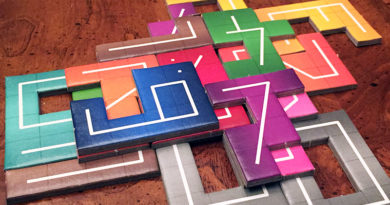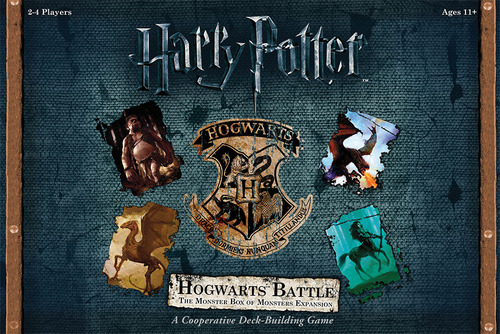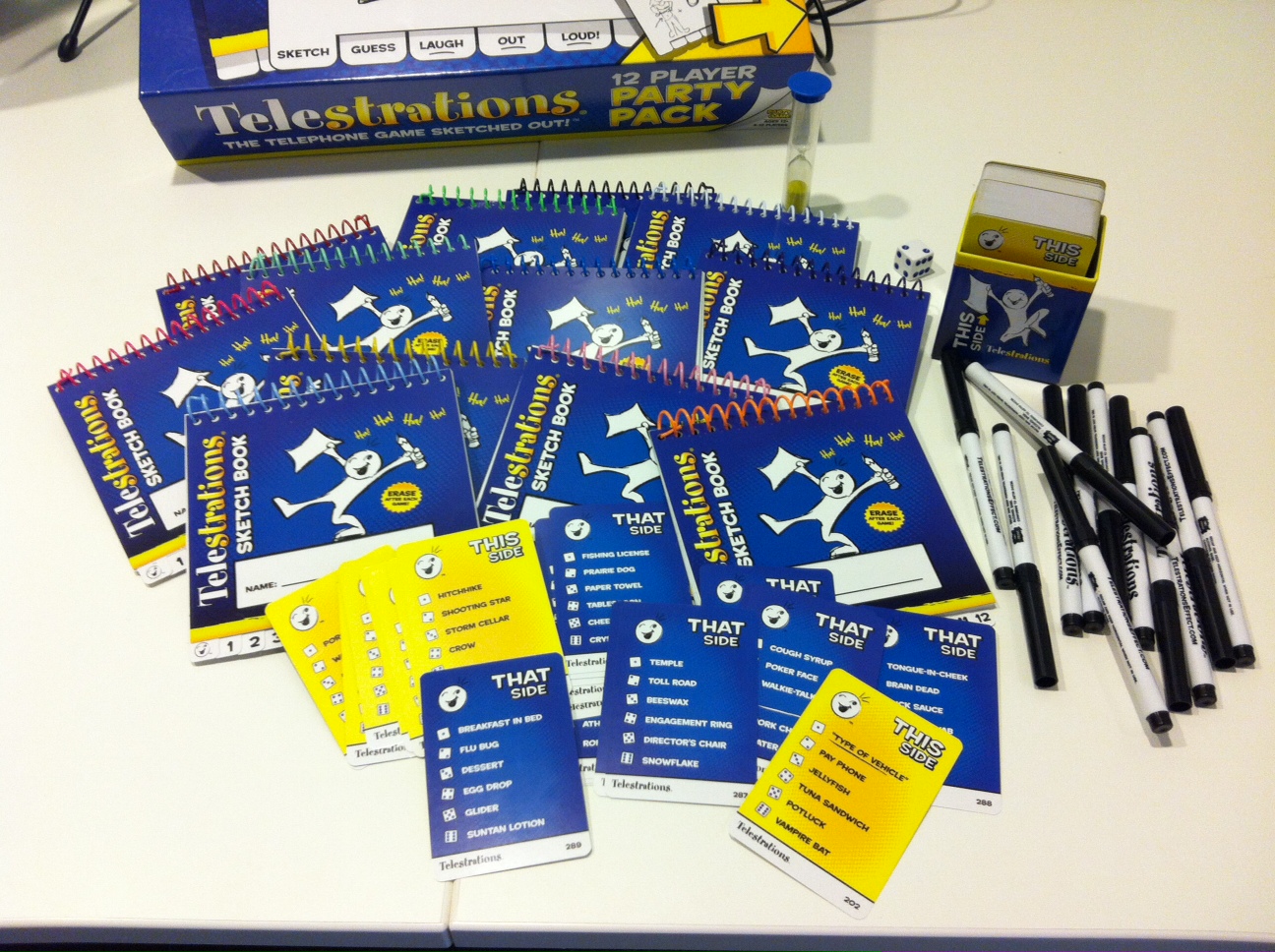Got any Spies and Turncoats?
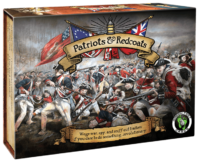
“These are the times that try men’s souls.”
I’m sure many people may have uttered that phrase this past year. But we’re not here to talk about last year. Instead, we’re looking back to 1776 when Thomas Paine penned those words in The American Crisis.
Of course, we’re not here for a book report either, but instead to look at a social deduction card game set during the American Revolutionary War — Patriots & Redcoats by Green Feet Games.
In the game, players take on the roles of the Americans fighting to win independence and the British fighting to stop the rebellion. And like in typical social deduction type games, players are secretly assigned which side they’re on and must figure out who to eliminate to win.
But, be careful because players may also change loyalty along the way!
It’s a game that feels like a mix of The Resistance and Coup but with it’s own special flavor. And it’s also a game we’ve played a bunch of times over the last few months because of how fun it is.
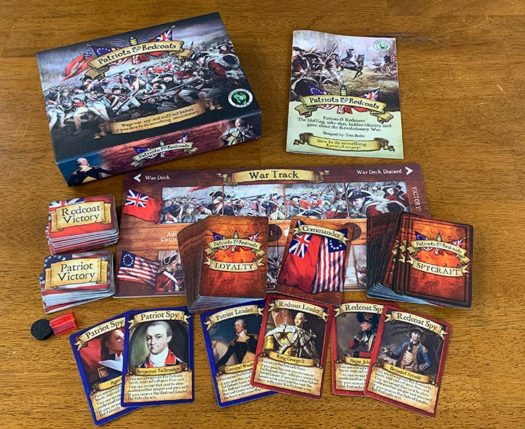
How to play Patriots & Redcoats
The objective in Patriots & Redcoats is to win by locating and eliminating the opposing Leader (General Washington or King George III) or by winning 4 victories on the battlefield.
Set up
To begin, players pull out the right number of Patriot and Redcoat Leader and Spy cards based on the number of players. Then they add to those cards from the regular Loyalty deck until it equals the number of players. Those are all dealt out so that everyone holds 1 card. Then players are each dealt 2 cards from the regular Loyalty deck.
Everyone secretly looks at their 3 cards to determine which side they’re starting on. If they hold one of the Leader or Spy cards, they’re on that side. If not, their side is determined by the majority in their hand — Patriot or Redcoat.
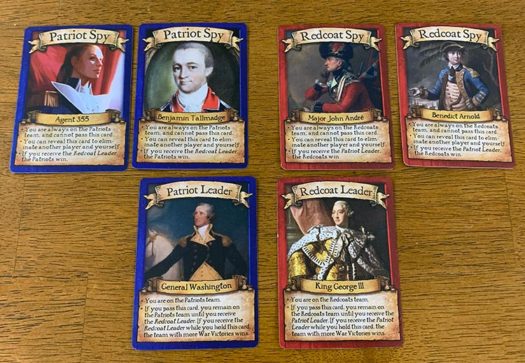
All players place their 3 cards facedown in front of them and everyone closes their eyes. Then someone calls out for the Patriot Leader and Patriot Spies to open their eyes and spot each other. Then the same is done for the Redcoat Leader and Spy (if playing with that many players).
The War tiles are shuffled and placed facedown near the War Track. The first Commander is then determined randomly and that player takes the Commander card stand and places in in front of them.
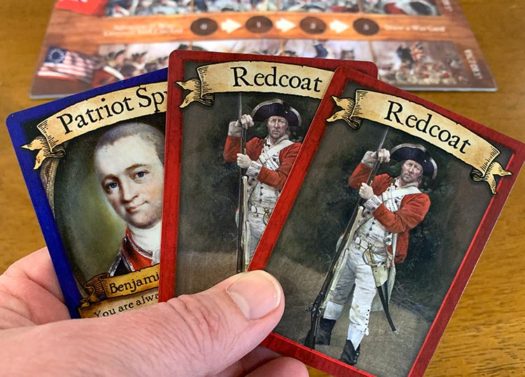
Playing
The game is played over a series of rounds. Each round consists of a Spycraft Phase and a Council Phase.
Spycraft Phase
Starting with the Commander for the round, each player takes a turn by drawing a Spycraft card from the deck and playing it.
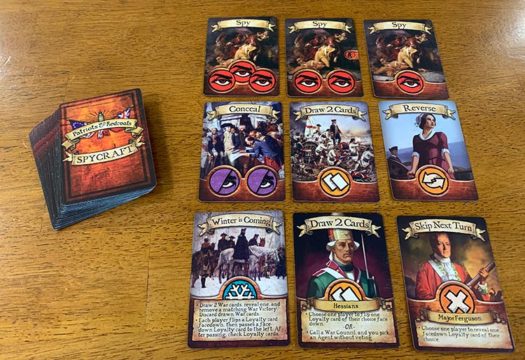
- Spy: This is the main way to discover player identities and try to capture the opposing Leader. If the card has Red Eye icons, the player plays it in front of another player. If a player ever has 3 Red Eye icons in front of them, they must turn over one of their cards.
- Conceal: The Purple Eye icons on the Conceal cards cancel the Spy icons. A player may play this card in front of another player who then discards the card plus the same number of Red Eye icons in front of them.
- Reverse: As you’d expect, the player order switches direction.
- Skip Next Turn: As you’d expect, play passes over the next player and continues.
- Draw 2 Cards: Draw 2 additional Spycraft cards and choose the order to resolve them.
- Winter is Coming: This is a special card that may change the game state dramatically.
When Winter is Coming is drawn, the player draws 2 War Tiles and choose one to reveal. A matching War Tile on the War Track is removed. Each player also chooses one of their face up Loyalty cards to turn face down. Then each player chooses one of the face down Loyalty cards to pass to the player on their left.
While the Spy Loyalty cards cannot be passed, any of the other Loyalty cards (including Leader cards) may be passed. If someone holding a Spy card receives the opposing Leader, they capture the Leader and win the game.
Otherwise players now reassess which side they’re on by checking these 3 points in order:
- If a player holds the Redcoat Spy or Patriot Spy, they are on that corresponding side.
- A player is a Redcoat if they most recently held the Redcoat Leader card and likewise a Patriot is they most recently held the Patriot Leader card.
- If none of those apply, then it’s again based on the majority of cards held — Redcoat side if most of the cards are Redcoat and Patriot if most are Patriot.
The round continues until play gets back to the Commander. Then it moves into the Council phase.
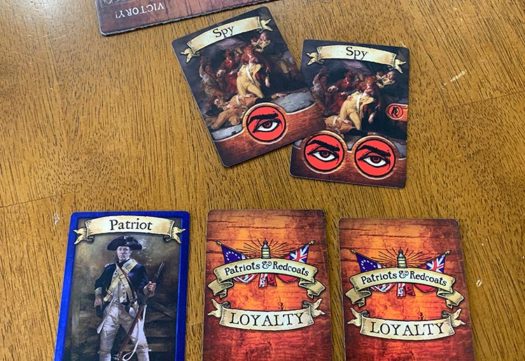
Council Phase
The Commander nominates another player to be his “Agent” at the War Council. Then all other players simultaneously reveal if they approve or not.
If the majority say “no”, the War marker moves forward one space on the track. If it reaches the final space, a random War tile is revealed and placed on the appropriate spot (Redcoat or Patriot).
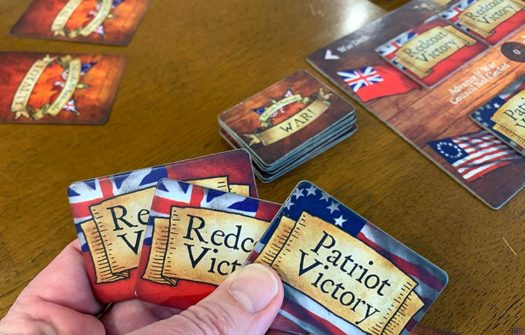
If the majority say “yes”, the Commander secretly draws 3 War Tiles and chooses 2 to pass to their Agent. The Agent then secretly selects 1 to reveal and place on the corresponding War Victory space. During this, the Commander and Agent may not communicate with each other. Only after the chosen War Tile is revealed and placed can players talk about it (truthfully or otherwise).
If a War Tile covers the final space on a Victory track, that side wins!
Otherwise, the Commander card is passed to the left and a new round begins.
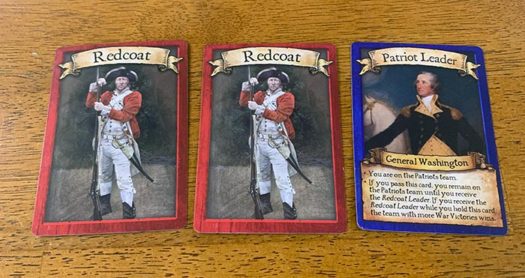
Game End
Rounds continue until one of the victory conditions is met.
- A 4th War Victory tile is placed on the Redcoat or Patriot War Track. The side to do so wins.
- A Redcoat or Patriot Leader card is turned face up in front of a player. The opposing side captured that Leader and wins.
- A Redcoat or Patriot Spy receives the opposing Leader card during Winter is Coming. The side of the Spy wins.
- A player holding a Leader card receives the opposing Leader card during Winter is Coming. Both Leaders are eliminated and the side furthers on the War Victory track wins.
Alternatively, a player holding a Spy Loyalty card may reveal it at any time to completely eliminate another player. In doing so, the Spy is also eliminated. But if the player they choose holds a Leader card, that player must reveal their Leader. That Leader’s side loses the game.
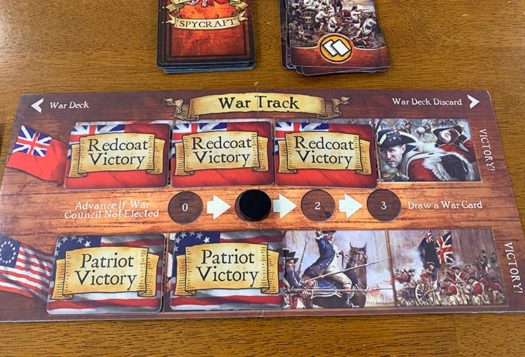
Can the whole family enjoy Patriots & Redcoats?
Although Patriots & Redcoats says 8+ on the game box, we’d say the ideal ages for players is 12+. It’s not that the rules are too hard for younger players to pick it up, but rather we don’t see it as a theme or type of game to draw younger kids’ interest.
Sure, there will be outliers, so you don’t need to tell us your 7-year old loves the game. We totally get that point since we had a 5 year old that loved playing BANG!
But if you’re checking out this game for your family, we’d recommend it more for teens and adults. That’s where the bluffing and guessing who’s on which side will play out the strongest.
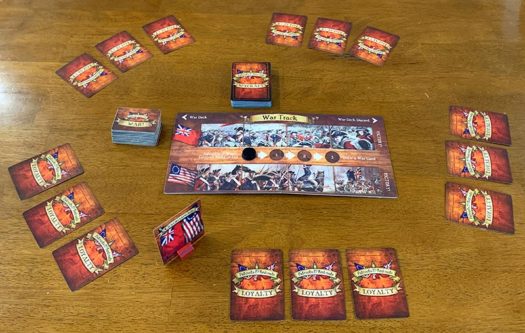
We also like that it’s not a straight up bluffing game like many social deduction games are. Instead, you’re going to have 3 cards in front of you and you strategically choose which ones to reveal when forced to do so.
Other than that, you mostly spend the game trying to figure out who should be the target of your cards to force out — but with a lot of table chatter to go along with it.
We’ve found that the only real bluffing comes into play during the War Councils. Or I should say, “after” the War Councils when the Commander and Agent can claim what tiles they were handed and chose to play.
We’re also big fans of Coup and The Resistance and enjoy such deduction games. But Patriots & Redcoats stands on its own for a number of reasons we really like.
The first is the deck of cards to play through that brings in a random element of luck. Rather than just pin-pointing people to target, the card deck mixes things up a bunch. It means that not everyone gets a chance to play a Spy card on another player. You may want to, but draw a Conceal instead.
Although that can be fun too when someone has a couple of Spies on them and you choose to discard the Conceal card rather than giving it to them!
Then there are the skip and reverse cards that mix up whose turn is next. And sometimes that means skipping over the Commander or reversing right back to the Commander for another War Council immediately. Each of these twists keep us on our toes every game.
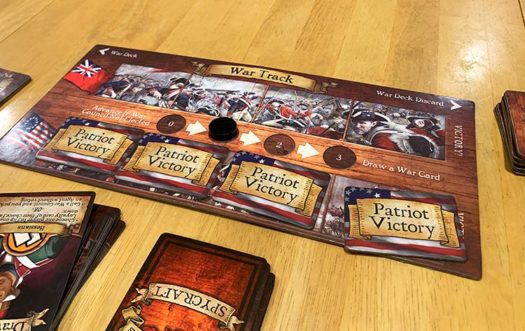
We also really like that there are Turncoat cards in the Loyalty deck. This often means that the player can choose which side they want to be on. For example, if I have 1 Redcoat, 1 Patriot, and 1 Turncoat, I can choose which side the Turncoat is on. That’s turned a number of people at the end of a game. 🙂
But perhaps the element we enjoy the most is when winter comes and we have to pass a card to our left — and potentially switch alliances!
It’s a great twist and is something we’re always talking about at the end of a game.
How does Patriots & Redcoats score on our “Let’s Play Again” game meter?
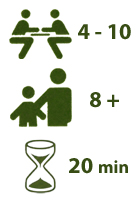 Patriots & Redcoats scores high on our “Let’s Play Again” game meter for a number of reasons. The first is that we love the social deduction element without needing to bluff. Yes, you can, but it doesn’t rely on that for fun.
Patriots & Redcoats scores high on our “Let’s Play Again” game meter for a number of reasons. The first is that we love the social deduction element without needing to bluff. Yes, you can, but it doesn’t rely on that for fun.
It’s also a relatively short game that accommodates many players. And with many people surfacing from the pandemic-induced isolation (thanks to vaccines getting out), it’s fantastic to get together and play games with more people again.
We have yet to play Patriots & Redcoats without playing at least 3 games in a row.
Plus, we also enjoy the American Revolution theme.
So if you’re looking for a solid social deduction game for your next group game night, we’d recommend Patriots & Redcoats.
We’d like to thank Green Feet Games for a review copy of Patriots & Redcoats.



